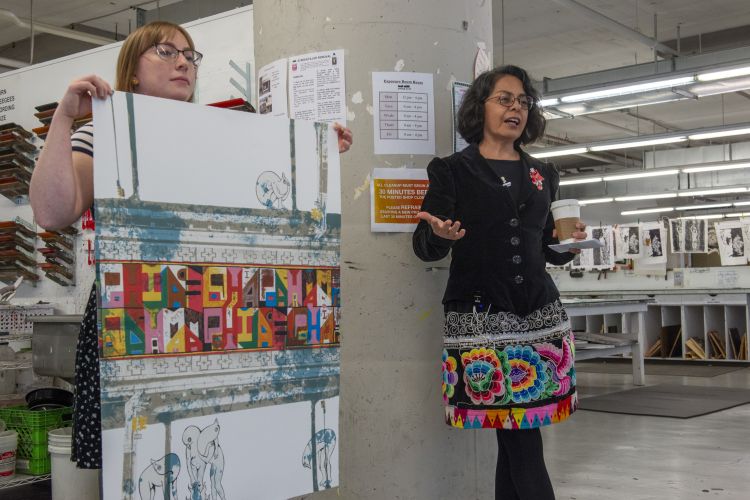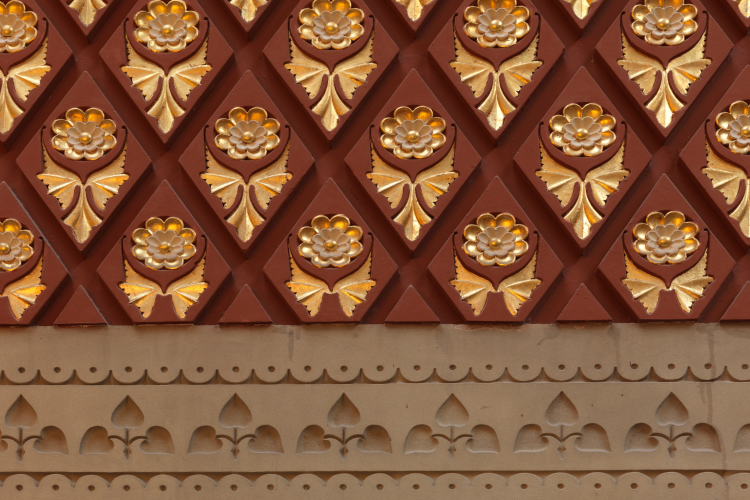STORIES FROM PAFA
Madeline Peckenpaugh
In the Studio with Madeline Peckenpaugh

Madeline Peckenpaugh’s (BFA '15) handprints are all over her paintings.
She makes the stretcher bars for each canvas, with most pieces being no more than 6 feet wide.
“I can still physically handle that size, they’re always within my arm span,” she said. “I’m making my stretcher bars, I’m cutting the wood, and I can carry the painting. I just want to do it on my own.”
She works quietly alone in a studio in Philadelphia’s Italian Market.
Mixing a dozen paints can take up to an hour, as she finds the right colors to interact with one another.
“Once I mix one, then the one I’m mixing next to it has to be in conversation,” Peckenpaugh said. “Once I have all of these colors I have to start. If I stare at this thing for too long it’s like, ‘What is going on?’”
She starts quickly and works fast, with some paintings only taking a few hours, revealing a canvas that plays between decaying nature and emerging construction. They are a reflection of her upbringing in Wisconsin, a place she describes as very marshy, and her home now in Philadelphia.
“I always document sites of construction; it’s this back and forth of life and decay,” she said. “I like the hardness of new construction being fabricated along with nature taking over. It’s like this back and forth conversation of something hard and manmade and something we don’t have control over.”
The conversation of each painting begins in her hands. She often shies away from paintbrushes, instead adding paint to the canvas with glove-covered fingers and palms. The first layer of a painting usually takes between 30 minutes to an hour.
“The first color that I put on usually dictates the space of the painting. So as I’m adding more colors in the foreground and the background, I start to weave them together to make the space and it’s really fast action painting,” she said.
The second layer is when the structures begin to emerge in Peckenpaugh’s work. She says it was always in the canvas and her mind but is added last so it can be weaved into the organic growth and plants.
“If I were to do it first then the plant life would overlap onto it and cause a texture problem and you would see how I layered the painting; which I don’t want you to know. I don’t want anyone to know the structure was there the whole time,” she said.
Peckenpaugh challenges not only viewers of her work but herself, often changing materials when she starts to feel herself slipping into a method of working that seems, in her words, too easy. In addition to using spatulas and pallet knives, Peckenpaugh recently started using the cardboard roll from paper towels as a tool.
“The other day I was painting and this mark I was making was the same and the painting was all saying the same thing,” she said. “I ran out of paper towels and I had the cardboard tube so I started using the tube on the painting. It was the best mark I’d made in a while so that’s my tool of use right now, cardboard rolls which I tear apart and the frays of it makes different lines.”
Making the most of a situation to better her work is Peckenpaugh’s style. In the fall of 2016, Peckenpaugh spent a month in Nepal through the PAFA Fellowship’s Patan Museum Residency. On the last day of her residency she inadvertently drank contaminated water and contracted typhoid. She spent a week in a local hospital, at one point spiking a fever of nearly 105 degrees. She then recovered in the home of a Nepalese family.
“When I was in the hospital my fever was so high I couldn’t think. It was the first time ever that there was nothing happening so it was this quiet and peacefulness. Time didn’t really seem to exist because I wasn’t doing anything. I just knew what time it was by watching the window and the sun and it was very removed,” she said.“ I felt like I was removed from my body. I want that feeling to affect my entire life, turning off your thoughts and feeling present.”
She has since taken up yoga and meditation and has more faith in the universe.
It’s too early to see the direct impact of the experience in her work but Peckenpaugh says all of her work now is affected by her time in Nepal.
“I’ve since learned that I just need to stick with what feels right.”
—LeAnne Matlach (LMatlach@pafa.org)


